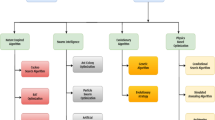Abstract
Energy efficiency and security are considered as two crucial issues in the design of MANET. In this paper, an energy efficient stable as well as secure clustering (EESSC) technique is presented for MANET. The presented EESSC technique makes use of fuzzy logic mechanism to select the cluster heads (CHs) properly by the use of five variables namely remaining energy level, node degree, distance, trust level and node mobility. In addition, a standby CH (SBCH) is also introduced to find useful in case of accidental cases like CH dies, CH moves out of the cluster or CH is comprises. In such case, SBCH is invoked to act as CH and again another SBCH is chosen. This process helps to achieve network availability with no disturbances along with the additional level of security. The simulation of the EESSC takes place under diverse aspects and the outcome verified the betterment of the presented model over the compared ones. From the simulation outcome, under the simulation time of 250 s, the CH changes takes place by 19 times whereas a maximum of 28 and 30 CHs were changed by the existing EWCA and EESSC methods respectively.










Similar content being viewed by others
References
Reddy AP, Satyanarayana N (2017) Energy-efficient stable multipath routing in MANET. Wirel Netw 23(7):2083–2091
Alfa AA, Sanjay M, Damaševičius R, Maskeliūnas R, Ahuja R (2018) The implications of deploying MANETs routing protocols in WLANs setup. International Journal of Pure and Applied Mathematics 119(16):2233–2243
Arjunan S, Pothula S, Ponnurangam D (2018) F5N-based unequal clustering protocol (F5NUCP) for wireless sensor networks. International Journal of Communication Systems 31(17):e3811
Arjunan S, Sujatha P (2018) Lifetime maximization of wireless sensor network using fuzzy based unequal clustering and ACO based routing hybrid protocol. Appl Intell 48(8):2229–2246
Bokhari DM, Hatem SH, Shams TS (2012) A review of clustering algorithms as applied in MANETs. International Journal of Advanced Research in Computer Science and Software Engineering, 2(11)
Chatterjee M, Das SK, Turgut D (2000) An on-demand weighted clustering algorithm (WCA) for ad hoc networks. In Globecom'00-IEEE. Global Telecommunications Conference. Conference Record (Cat. No. 00CH37137) (Vol. 3, pp. 1697-1701). IEEE
Choi W, Woo M (2006) A distributed weighted clustering algorithm for mobile ad hoc networks. In Advanced Int'l Conference on Telecommunications and Int'l Conference on Internet and Web Applications and Services (AICT-ICIW'06) (pp. 73-73). IEEE
Bednarczyk W, Gajewski P (2013) An enhanced algorithm for MANET clustering based on weighted parameters. Universal Journal of Communications and Network 1(3):88–94
Low CP, Fang C, Ng JM, Ang YH (2008) Efficient load-balanced clustering algorithms for wireless sensor networks. Comput Commun 31(4):750–759
Goldberg DE (1989) Genetic algorithms in search, optimization, and machine learning, Addison Wesley, Reading, MA. SUMMARY THE APPLICATIONS OF GA-GENETIC ALGORITHM FOR DEALING WITH SOME OPTIMAL CALCULATIONS IN ECONOMICS
Gupta SK, Kuila P, Jana PK (2013) GAR: an energy efficient GA-based routing for wireless sensor networks. In International conference on distributed computing and internet technology (pp. 267-277). Springer, Berlin, Heidelberg
Keerthipriya N, Latha RS (2015) Adaptive cluster formation in MANET using particle swarm optimization. In 2015 3rd International Conference on Signal Processing, Communication and Networking (ICSCN) (pp. 1-7). IEEE
Jamali S, Rezaei L, Gudakahriz SJ (2013) An energy-efficient routing protocol for MANETs: a particle swarm optimization approach. Journal of applied research and technology 11(6):803–812
Kuila P, Jana PK (2014) Energy efficient clustering and routing algorithms for wireless sensor networks: particle swarm optimization approach. Eng Appl Artif Intell 33:127–140
Shahzad W, Khan FA, Siddiqui AB (2009) Clustering in mobile ad hoc networks using comprehensive learning particle swarm optimization (CLPSO). In International Conference on Future Generation Communication and Networking (pp. 342-349). Springer, Berlin, Heidelberg
Khatoon N (2017) Mobility Aware Energy Efficient Clustering for MANET: A Bio-Inspired Approach with Particle Swarm Optimization Wireless Communications and Mobile Computing, 2017
Author information
Authors and Affiliations
Corresponding author
Additional information
Guest Editors: Mohamed Elhoseny, Xiaohui Yuan, and Saru Kumari
Publisher’s note
Springer Nature remains neutral with regard to jurisdictional claims in published maps and institutional affiliations.
This article is part of the Topical Collection: Special Issue on Future Networking Applications Plethora for Smart Cities
Rights and permissions
About this article
Cite this article
M V S S, N., Babu, A.R. An efficient mobility aware stable and secure clustering protocol for mobile ADHOC networks. Peer-to-Peer Netw. Appl. 13, 1185–1192 (2020). https://doi.org/10.1007/s12083-019-00868-3
Received:
Accepted:
Published:
Issue Date:
DOI: https://doi.org/10.1007/s12083-019-00868-3




